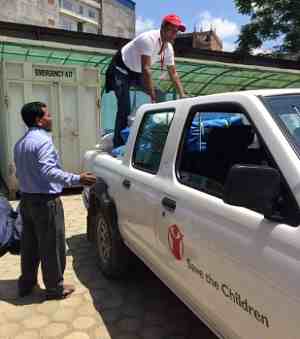CARE Cares for Quake-hit People in Haiti
Six months after an earthquake killed more than 220,000 people in Haiti and displaced another 1.5 million, CARE is ramping up efforts to ensure that survivors have a sturdy roof over their heads and a strong foundation to rebuild their lives.
CARE, which is constructing 25 to 30 transitional shelters per week, is on pace to complete up to 2,000 of the structures by December. And CARE plans to distribute 20,000 shelter reinforcement kits containing wooden planks, nails, rope, hurricane straps and other materials.
Strengthening self-built structures will be particularly critical as Haiti moves deeper into what forecasters predict will be a busy hurricane season.
“In many cases we’re working with widows, women-headed households and other vulnerable people,” said Dr. Helene Gayle, president and CEO of CARE. “On a basic level, shelter gives them privacy, dignity and safety. But it also provides a base from which to recover. We’ve found that even those Haitians who have lost the most haven’t lost the will to rebuild their country.”
In camps of displaced people, CARE has supported the formation of volunteer committees that, like the camps themselves, tend to have more women than men.
In many cases these women have stepped into leadership roles, assuring CARE reaches those most in need and spreads life-saving information about hygiene, health and psychological support for children. These women leaders also are helping raise awareness about the prevention of gender-based violence.
Whenever possible, CARE is helping families move out of camps and back into their communities. Building on its 56 years of experience in Haiti, the humanitarian group is providing economic opportunities, strengthening governance and improving health and educational services — both in earthquake-affected communities and outlying provinces.
CARE’s five-year, $100 million plan for relief and rehabilitation in Haiti is divided up into three phases and contains a special emphasis on meeting the needs of women and girls. In the initial phase, CARE reached more than 310,000 people through the distribution of food, water purification packets, water, jerry cans, hygiene kits, shelter kits, emergency housing repair kits, mattresses, blankets, newborn kits, clean delivery kits, latrines, bathrooms and other projects promoting hygiene and sanitation.
CARE has started planning its long-term strategy for the rehabilitation phase, which will be consistent with priorities in Haiti’s national reconstruction plan.
But CARE’s 380-person staff – most of them Haitian – is largely focused on turning relief into recovery.
There are few better symbols of the transition than the hundreds of wood-framed, metal-roofed shelters rising in hard-hit areas of Leogane and Carrefour. Standing roughly 13 feet by 15 feet (4 meters by 4.5 meters), they are earthquake- and wind-resistant, designed to last at least three years and up to a decade with maintenance.
Land tenure is a complex issue in Haiti. But CARE is working with land owners and local governments to ensure many landless families gain access to a secure place for their transitional shelter. Volunteer committees supported by CARE help identify households that are particularly vulnerable: many are elderly women, pregnant mothers and widows.
“CARE has built a committed team, investing lots of time and effort in community engagement, training and sensitization,” said Jim Kennedy, CARE’s shelter coordinator in Haiti. “We have a very good foundation for continued implementation of the transitional shelter projects.”
With the help of two CARE carpenters and three friends or family members, each shelter takes just two days to build. Designed for a family of five, they often sleep eight, nine or 10.
Perhaps most importantly, the transitional structures are designed to be adapted. They can form the core of a permanent dwelling that more closely resembles local housing styles.
In that way, the shelters are like the recovery itself: a collaboration between groups such as CARE and earthquake survivors who, ultimately, will determine how to rebuild all those places in Haiti called home.
CARE has over 60 years of experience delivering emergency aid with ongoing poverty-fighting projects in 72 countries.





